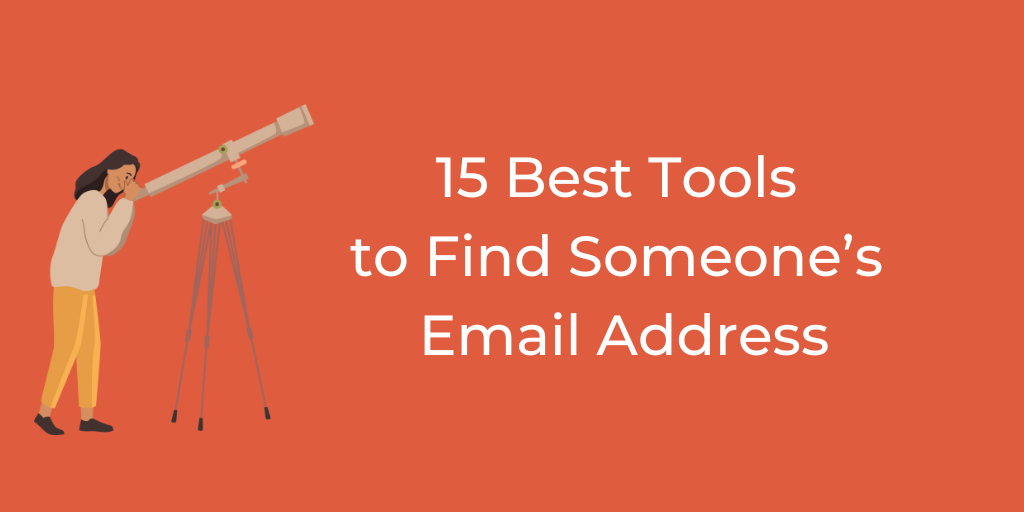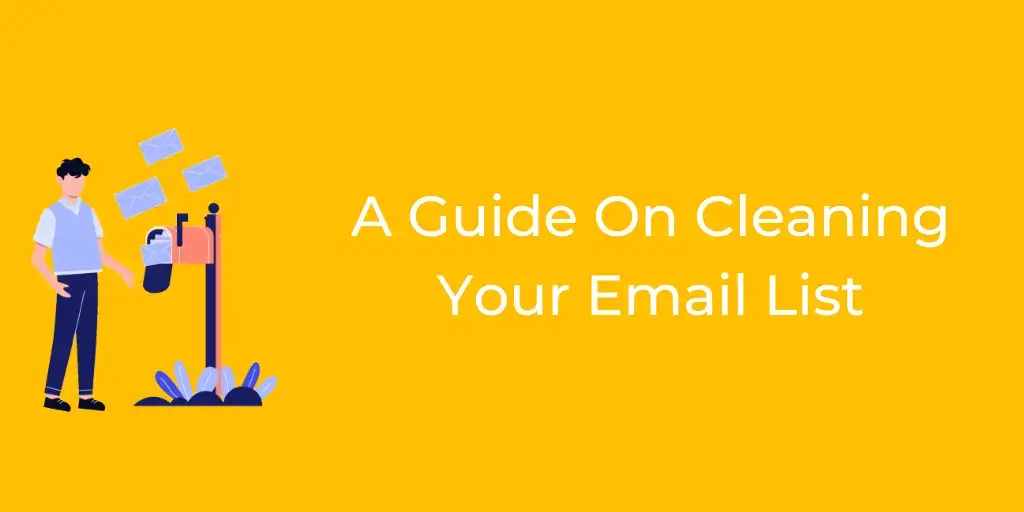
Quick links
A clean email list is the foundation of a successful email marketing strategy. Regularly maintaining your list improves deliverability, engagement rates, and overall campaign performance.
In this guide. we’ll walk you through every step of the process—from analyzing your current list to re-engaging inactive subscribers and keeping your list fresh with ongoing maintenance.
Step 1: Analyze your current email list
Before making any changes, you should take a closer look at your existing email list. Understanding how subscribers interact with your emails will help you identify inactive users, potential issues, and opportunities for improvement.
Evaluate email engagement metrics
The first step in analyzing your list is to assess engagement. Open rates, click-through rates (CTR), and bounce rates are key indicators of how well your audience is interacting with your emails.
- Open Rates: A healthy open rate varies depending on your industry, but a general benchmark is around 17-28%. If your open rates are significantly lower, it’s a sign that many subscribers may no longer be interested in your content—or worse, your emails could be landing in spam folders.
- Click-Through Rates: CTR provides deeper insight into how engaged your subscribers are. An average CTR of 2–5% is common, but if your rates are falling below that, it might be time to rethink your content strategy or target audience.
- Bounce Rates: High bounce rates can damage your sender reputation. A bounce rate above 2% should raise a red flag, indicating it’s time to remove invalid or outdated addresses.
Once you’ve identified inactive subscribers (typically those who haven’t engaged in the past 3 to 6 months), segment them into a separate list. This way, you can focus on re-engagement strategies or remove them if they remain unresponsive.
Look for hard and soft bounces
Bounced emails can harm your sender score and negatively affect email deliverability. It’s important to understand the difference between hard bounces and soft bounces to take appropriate action.
- Hard Bounces: These occur when an email is permanently undeliverable, usually due to an invalid or non-existent email address. For example, if someone mistyped their email when signing up, you’ll see a hard bounce. Removing hard bounces immediately is important because keeping these addresses on your list can trigger spam filters.
- Soft Bounces: Unlike hard bounces, soft bounces are temporary issues. These can occur if a recipient’s inbox is full, their server is down, or there’s a temporary network error. Soft bounces don’t require immediate action, but if the same address continues to soft bounce over several campaigns, it’s worth reviewing and potentially removing that contact.
Segment your list
If you want to make sure your messages reach the right people at the right time, you need to segment your email list. By grouping subscribers based on their activity levels, you can customize your campaigns and avoid wasting resources on unengaged contacts.
A good place to start is by dividing your list into three core segments:
- Active Subscribers: These are your most engaged contacts—those who’ve opened, clicked, or interacted with your emails within the last three months. Focus on nurturing these subscribers with personalized content and offers to keep them engaged.
- Inactive Subscribers: These are contacts who haven’t engaged in the past 6 to 12 months. They might still be interested in your content but need a little nudge to re-engage. Consider running a re-engagement campaign to win them back.
- Invalid or Bounced Emails: This group includes hard bounces, unsubscribed contacts, and invalid addresses. Removing them regularly helps protect your sender score and improves deliverability.
Step 2: Remove invalid and fake email addresses
An email list is only as good as the addresses on it. Invalid and fake email addresses can increase bounce rates and reduce deliverability. Cleaning up your list regularly is the only way to make sure that your emails are landing in real inboxes, not bouncing back or disappearing into the void.
Use an email verification tool
Even the best-managed email lists can accumulate fake, invalid, or temporary addresses over time. People make typos when signing up, use throwaway emails to access gated content, or even enter fake addresses just to get past forms.
All of these can harm your email list quality, leading to higher bounce rates, reduced deliverability, and a damaged sender reputation.
To prevent these issues, regular use of an email verification tool is essential. These services scan your list for problem addresses and flag any that are likely to cause issues.
Here’s a comparison of some popular tools:
| Tool | Key Features | Best For |
| ZeroBounce | Detects invalid, fake, and temporary emails. Identifies spam traps. | Comprehensive list cleaning and spam trap detection. |
| Hunter | Verifies professional emails and domains. Offers email address sourcing. | B2B lists and verifying business emails. |
| NeverBounce | Real-time verification with high accuracy. Detects disposable and catch-all domains. | Large lists with frequent updates. |
Running your list through one of these tools can help detect several types of problematic addresses. Invalid addresses are a common issue and include misspelled or non-existent domains that will never accept emails.
Temporary emails, often used by users who want one-time access to gated content, can inflate your list with low-value contacts. And spam traps—email addresses set up by providers to catch senders who aren’t maintaining proper list hygiene—can harm your sender reputation if not removed.
Once the verification tool flags these addresses, it’s essential to take action. Remove any confirmed invalid or disposable addresses immediately to improve your list’s quality.
Monitor for typos and errors
Human error is inevitable when people type in their email addresses– but typos can lead to bounced emails. For example, it’s easy to accidentally type @gnail.com instead of @gmail.com or @yaho.com instead of @yahoo.com. These minor mistakes can add up over time, hurting your deliverability rates.
While automated tools can catch some of these issues, a manual review of recent sign-ups can also help when cleaning up your email list. Correcting small typos manually, especially for addresses that look legitimate otherwise, is a good way to salvage valuable contacts rather than losing them due to a simple error.
For example:
- Correctable Errors: Look for typos in domain names and fix them if it’s clear what the user intended (e.g., “gnail.com” to “gmail.com”).
- Unrecoverable Errors: If the entire address looks fake or nonsensical, it’s best to remove it to protect your list’s quality.
Regular monitoring for typos and errors will keep list remains accurate, reducing bounce rates and increasing your chances of reaching real, engaged subscribers.
Step 3: Re-engage inactive subscribers
Inactive subscribers are a normal part of email marketing, but leaving them on your list without action can hurt your engagement rates and overall deliverability. Instead of immediately removing them, take a strategic approach to win them back.
A re-engagement campaign gives these contacts a chance to reconnect with your brand before you decide whether to keep or remove them from your list.
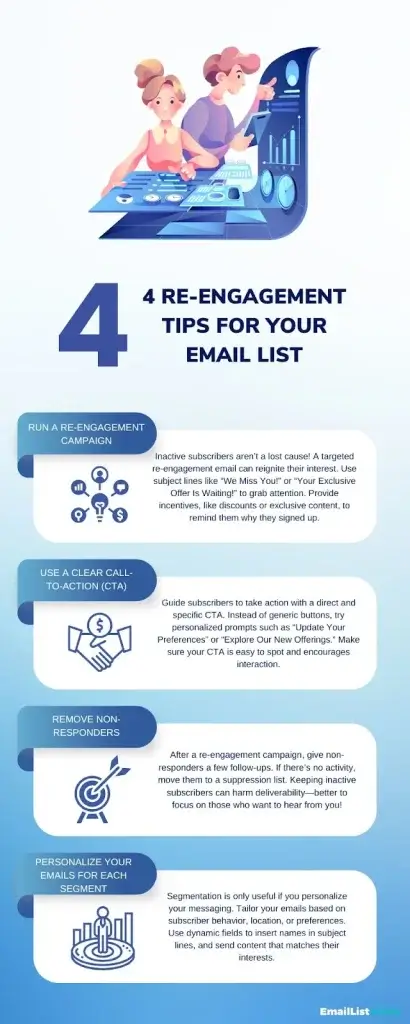
Run a re-engagement campaign
A successful re-engagement campaign starts with a compelling message that catches attention. Your email should acknowledge their inactivity and offer a reason to stay on your list.
This could be an exclusive offer, a reminder of your brand’s value, or simply a check-in to see if they’re still interested.
Subject lines are crucial—they’re the first thing a subscriber sees and determine whether they’ll open the email. Consider using attention-grabbing lines like:
- “We Miss You! Are You Still Interested?”
- “Your Exclusive Offer Is Waiting!”
- “Are You Still With Us? Let’s Catch Up!”
These campaigns can include incentives such as discounts, free content, or access to special features. For example, a fitness brand might offer a free workout plan, while a SaaS company could provide a personalized product demo. The key is to make the subscribers feel valued and remind them why they signed up in the first place.
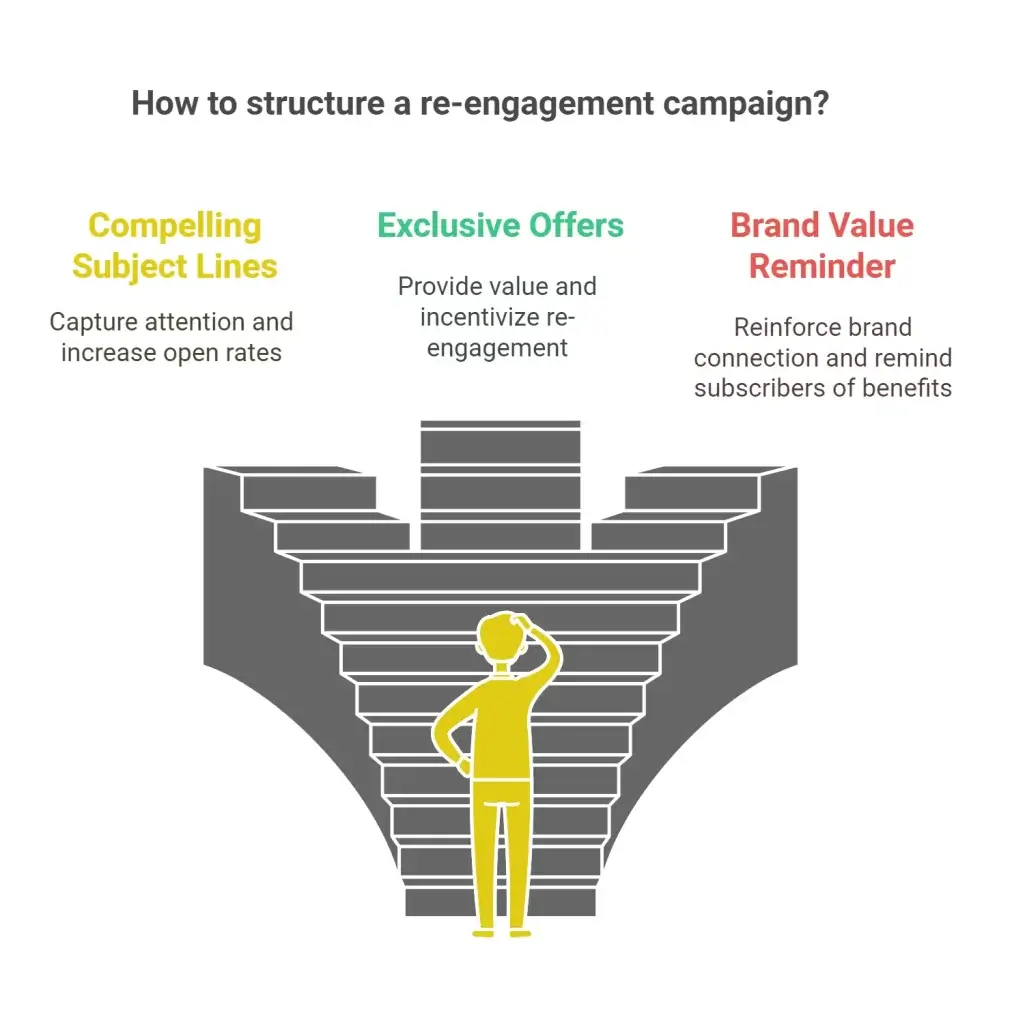
Use a clear Call-to-Action (CTA)
Once you’ve caught their attention, make it easy for subscribers to take action. A clear and direct call-to-action (CTA) is essential for guiding them toward re-engagement. Instead of generic CTAs like “Click Here,” use specific, personalized prompts that align with the purpose of your campaign.
Examples of effective re-engagement CTAs include:
- “Update Your Preferences” — Encourages subscribers to adjust their email preferences and choose the type of content they want to receive.
- “Confirm You Want to Stay on Our List” — A simple option to let subscribers opt back in.
- “Explore Our New Offerings” — Great for showcasing new products, services, or content that might reignite interest.
Make sure the CTA stands out visually, whether it’s a button or a bold link, and keep it easy to find.
Remove non-responders
Despite your best efforts, some subscribers won’t re-engage. Holding onto these inactive contacts can hurt your deliverability rates, as email providers monitor engagement to determine if your messages are worth delivering to the inbox.
After running a re-engagement campaign, give non-responders a reasonable timeframe—such as two or three follow-up emails—to take action. If they remain inactive, it’s time to remove them from your active list.
This doesn’t necessarily mean deleting them outright. Consider moving them to a suppression list, where they won’t receive regular campaigns but remain available for future targeted outreach, such as a special “win-back” offer down the line.
Step 4: Segment and optimize your cleaned email list
Once your email list is cleaned, the next step is to organize it into meaningful segments. Segmentation allows you to customize your messaging, improve engagement, and deliver the right content to the right audience.
Instead of sending generic emails to your entire list, breaking it into smaller groups based on shared traits or behaviors will help you build stronger connections and increase campaign effectiveness.
Think of your email list as a diverse group of customers with different needs and interests. The more personalized your approach, the better your results.
Create relevant segments
Segmentation isn’t just about splitting your list into random categories. When you segment your list, you’re grouping your subscribers based on data that can help you deliver more targeted, valuable content.
Here’s a practical way to think about segmentation by grouping contacts into three key categories:
| Segment Type | Examples of Criteria | Why It Matters |
| Activity Level | Frequent (last opened an email within 30 days), Occasional (engaged 3–6 months ago), Lapsed (no engagement for over a year) | Helps you adjust the frequency and type of messaging based on engagement. |
| Demographics | Age, location, gender | Allows you to send region-specific offers or age-relevant content. |
| Behavior | Purchase history, content clicks, website visits | Allows you to offer personalized product recommendations and content. |
For example, an online retailer could target frequent buyers with loyalty discounts, while occasional shoppers might benefit from a “come back” offer. Demographics can help guide campaigns based on regional events or holidays.
By creating segments that make sense for your brand, you can create personalized campaigns that speak directly to each group’s interests.
Personalize your email campaigns
Segmentation is only half the equation—what you do with those segments matters just as much. Personalizing your email campaigns based on segmentation makes your messaging feel more relevant and timely, which improves open rates, click-through rates, and conversions.
Start with small personalization touches, like using dynamic fields to include the recipient’s name in subject lines or greetings. But don’t stop there.
For example, if a subscriber has recently clicked on a specific product category, follow up with an email featuring related items or exclusive deals in that category.
Here’s a comparison to show the difference between a generic email and a personalized email campaign:
| Generic Email | Personalized Email |
| Subject Line: “Check Out Our New Products!” | Subject Line: “Hi Sarah, You Might Love These New Arrivals!” |
| Content: Random product recommendations | Content: Curated items based on browsing history |
| CTA: “Shop Now” | CTA: “Shop Again for More Styles You Love” |
The more personalized your campaigns, the more likely recipients are to feel valued and engaged with your brand. Segmentation and personalization work hand-in-hand to deliver better results and improve customer retention over time.
Step 5: Maintain email list hygiene regularly
Cleaning your email list isn’t a one-time job. It takes ongoing effort to maintain good deliverability and avoid spam complaints and bounces.
Just like routine maintenance for your car, regular email list cleanups keep things running smoothly.
Think of it as an investment in your email marketing performance—by removing unengaged contacts and keeping bounce rates low, you’ll see better open rates, fewer spam reports, and stronger overall results.
Schedule regular cleanups
Cleaning your email list every three to six months can significantly improve deliverability. By flagging and removing disengaged contacts regularly, you’ll prevent issues before they come up.
Automation tools are a great way to simplify this process, automatically identifying inactive subscribers and helping you decide whether to run re-engagement campaigns or remove them entirely.
Without regular cleanups, your list will accumulate outdated or fake addresses, leading to higher bounce rates and lower engagement. A clean list not only improves your email performance but also helps maintain a positive sender reputation with email providers like Gmail, Yahoo, and Outlook.
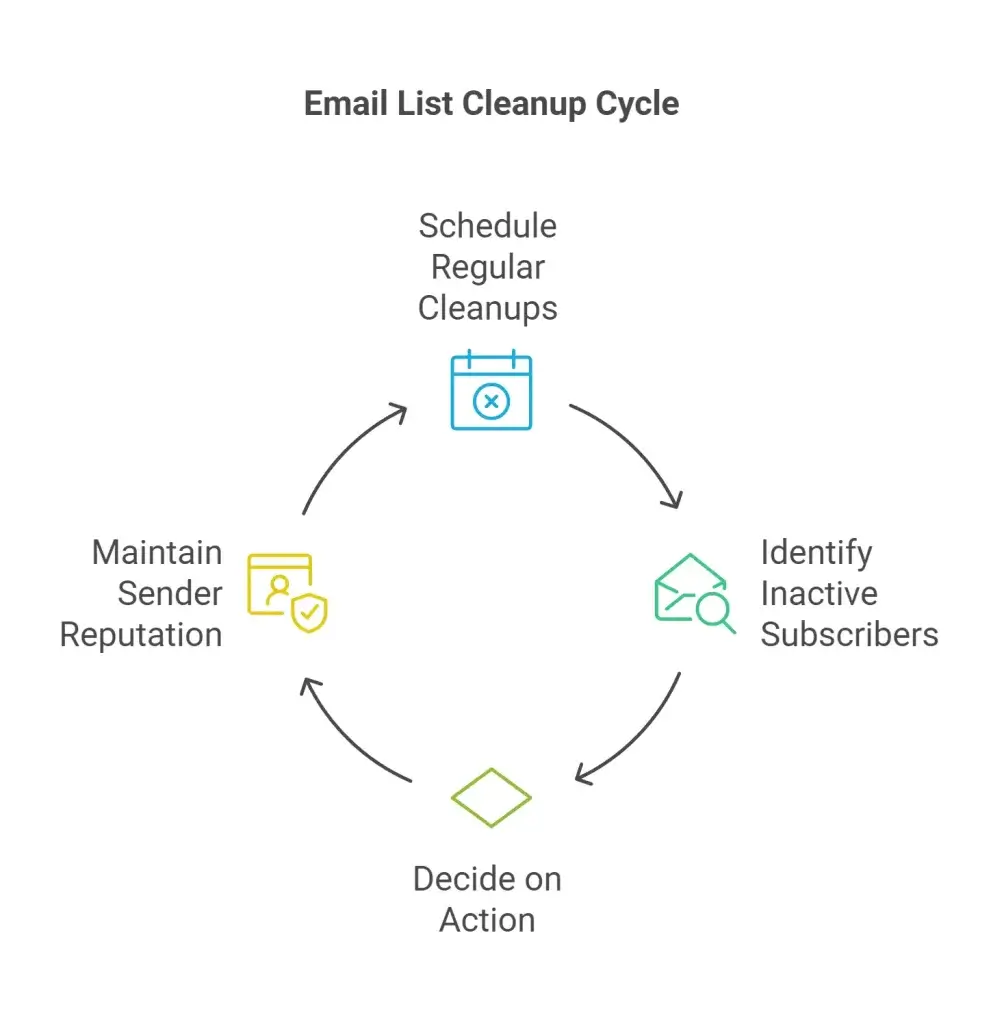
Use double opt-in for new subscribers
A great way to keep your email list clean is by having new subscribers confirm their email address through a double opt-in process.
This method requires subscribers to click a confirmation link in a follow-up email before being added to your list. While it might seem like an extra step that could reduce your sign-up rate slightly, it drastically reduces the chances of fake or spammy addresses ending up on your list.
Double opt-in protects you from spam traps—fake email addresses used by ISPs to catch bad list management practices—and also helps you build a list of genuinely interested subscribers. The result? Higher engagement rates and fewer headaches from hard bounces.
Monitor bounce rates and spam complaints
Bounce rates and spam complaints are critical metrics to watch because they directly affect your sender reputation. Ideally, you want to keep your bounce rate below 2%. Anything higher could signal to email providers that your list is outdated, potentially landing your emails in spam folders.
Spam complaints are even more damaging. If too many people mark your emails as spam, it tells providers that your messages are unwanted, which can result in your emails being blocked entirely. Regularly reviewing reports from your email service provider—whether it’s Mailchimp, ActiveCampaign, or another platform—will give you insights into how your emails are performing.
To stay on top of things, make it a habit to check these metrics after every major campaign. If you notice an increase in bounces or complaints, address it immediately by cleaning your list or adjusting your content strategy.
Tools to help clean your email list
To keep your list in top shape, you need reliable tools that can verify addresses, streamline your email campaigns, and provide insights into how your emails are performing.
Below are some of the best tools to help you clean and optimize your email list.
Email Verification Tools
Email verification tools help you confirm that every email address on your list is valid, active, and capable of receiving messages. Without verification, your list can become cluttered with fake, misspelled, or outdated addresses, which leads to high bounce rates and deliverability issues.
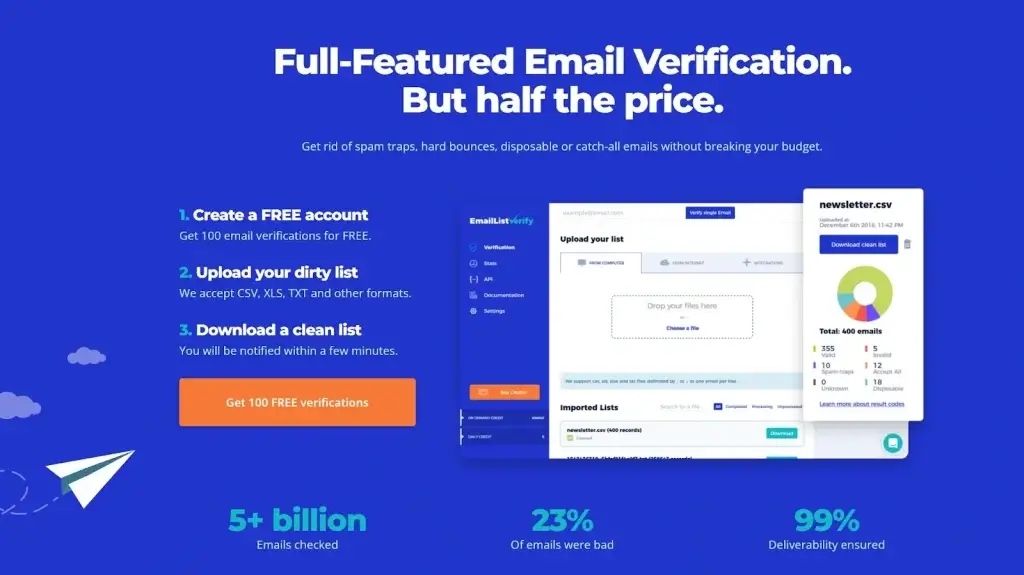
EmailListVerify is a must-have tool for anyone serious about email list hygiene. It’s fast, accurate, and trusted by thousands of businesses to reduce bounce rates, prevent spam complaints, and improve deliverability.
Here’s what makes EmailListVerify stand out:
- Real-Time Verification: Instantly flag fake or invalid addresses before they hit your list.
- Spam Trap Detection: Catch hidden spam traps that can ruin your sender reputation.
- Bulk List Cleaning: Upload your entire list for a thorough cleanup in minutes.
- Affordable and Scalable: No matter the size of your list, EmailListVerify offers flexible plans to fit your needs.
With EmailListVerify, you can say goodbye to hard bounces and fake signups so you can only engage with contacts who are real and active.
Email Marketing Platforms
Email marketing platforms are essential for managing your list, creating campaigns, and tracking performance. These tools allow you to automate messaging, personalize content, and ensure your emails reach the right audience at the right time.
Mailchimp is one of the most popular email marketing platforms, offering everything from list management to automation and detailed reporting. It’s a great tool for keeping your list organized and ensuring that your emails reach the right audience.
With features like automated segmentation, Mailchimp makes it easy to tailor your campaigns to different groups within your list. It also integrates seamlessly with tools like EmailListVerify, giving you an extra layer of protection against invalid addresses.
Analytics Tools
Tracking the performance of your email campaigns is essential to maintaining a healthy list. Analytics tools help you understand where your traffic is coming from, which campaigns are driving the most engagement, and where you can improve.
A good analytics tool will provide insights on:
- Click-through rates: See which emails are capturing attention.
- Conversions: Track the actions subscribers take after opening your email.
- Referral sources: Identify how subscribers found your content.
Some popular analytics tools include Google Analytics, which tracks traffic and conversions from email campaigns, and HubSpot, which offers detailed email performance reports within its platform. ActiveCampaign and Klaviyo are also great options, providing advanced reporting features tailored to e-commerce and engagement-focused campaigns.
Join Our Monthly Newsletter
Learn how to improve email deliverability and clean your email lists with and more.

